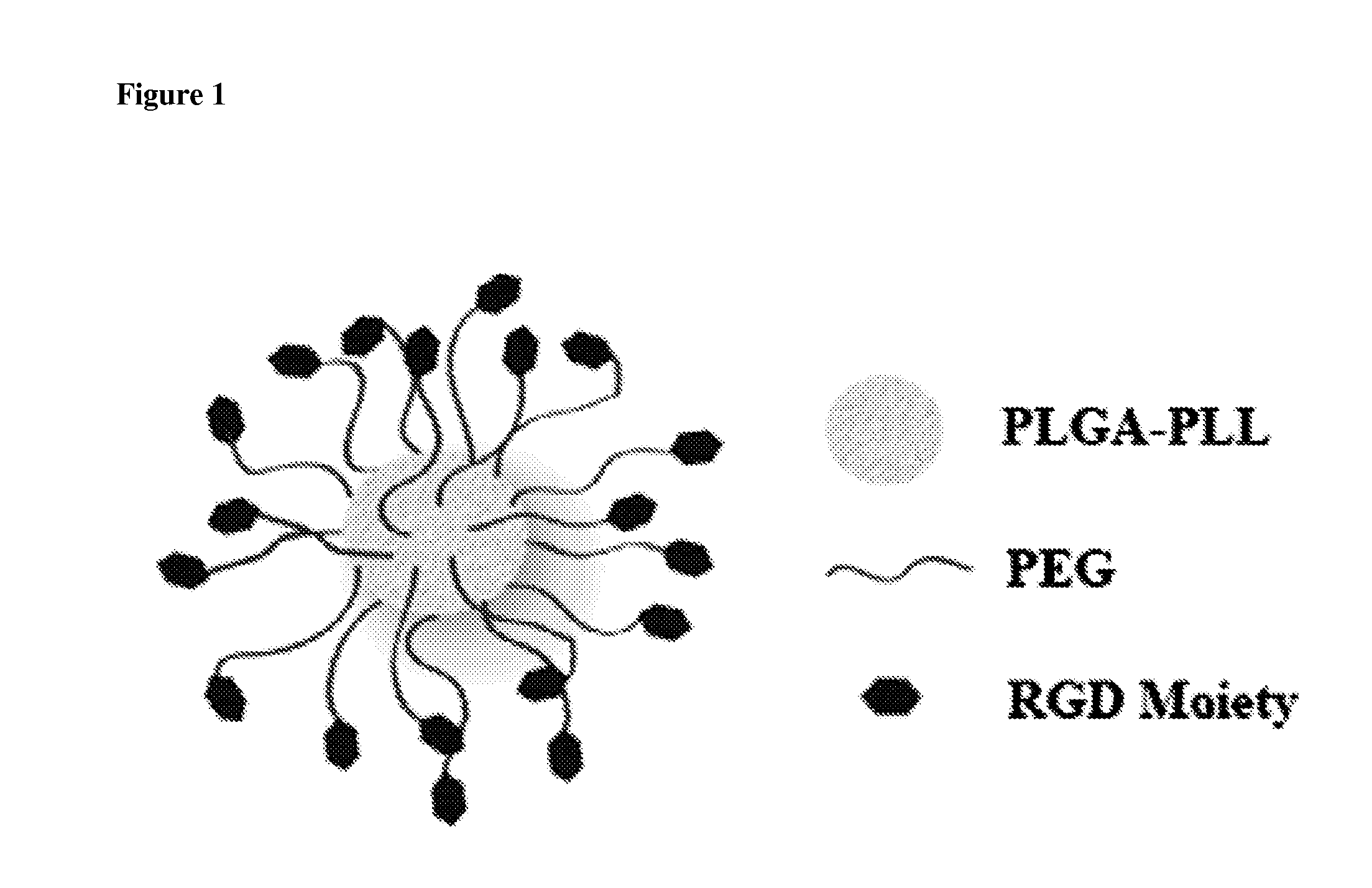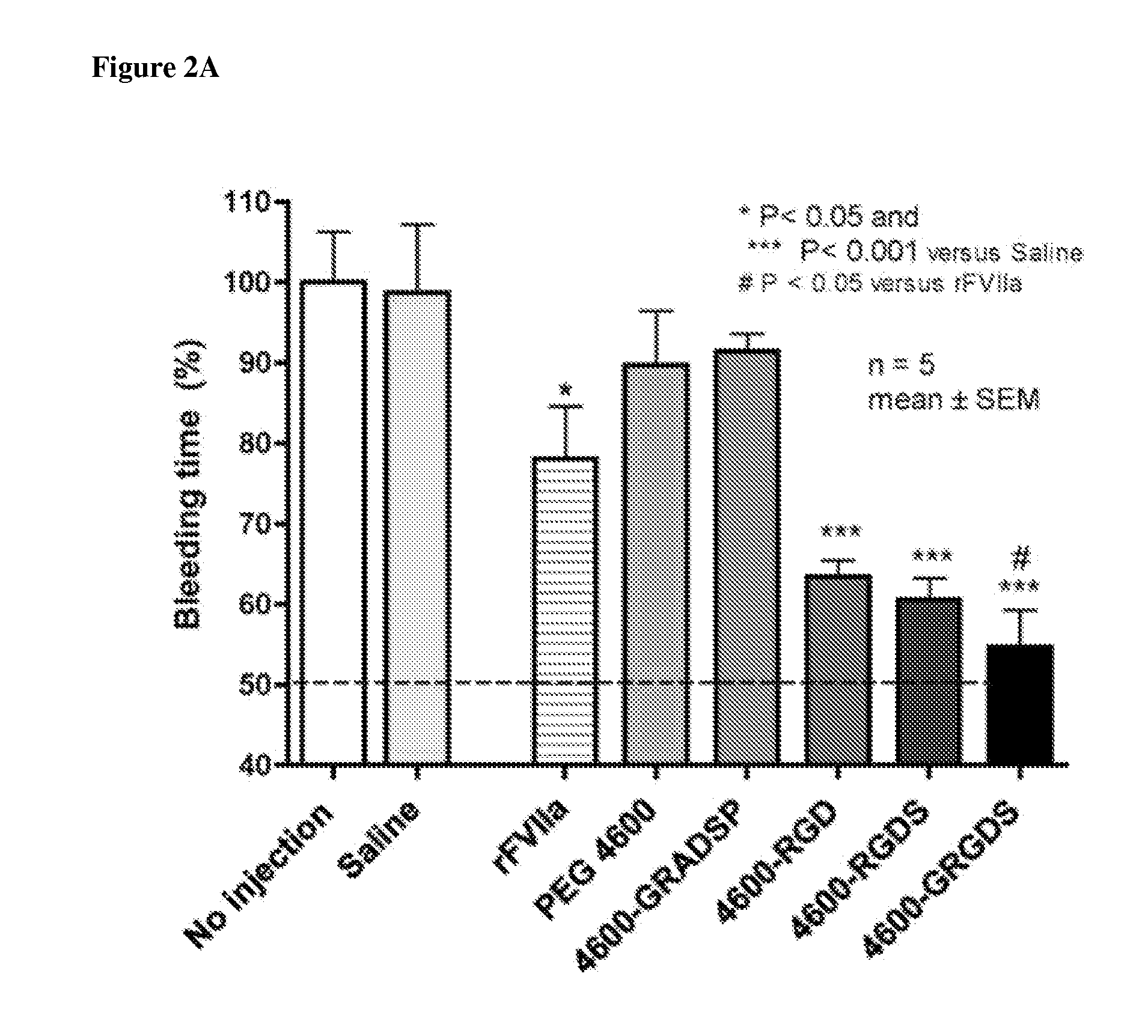Neutrally-charged synthetic platelets to mitigate complement response
a technology complement response, which is applied in the field of neutrophilly charged synthetic platelets to mitigate complement response, can solve the problems of poor functional outcomes, short shelf life of platelets, and short endogenous process, so as to reduce bleeding and improve trauma outcomes
- Summary
- Abstract
- Description
- Claims
- Application Information
AI Technical Summary
Benefits of technology
Problems solved by technology
Method used
Image
Examples
example 1
Nanoparticle Synthesis
[0117]Nanoparticles were synthesized from poly (lactic-co-glycolic acid)-poly-L-lysine (PLGA-PLL) block copolymer conjugated with polyethylene glycol (PEG) arms. Spherical nanoparticles were fabricated using a nano precipitation method as described herein. Dexamethasone was dissolved in a solvent, and the appropriate amount of polymer was also dissolved and mixed with the drug. The drug / polymer solution was pipetted dropwise into spinning 1×PBS. The resultant solution was allowed to stir uncovered for approximately 20 min at room temperature. After the nanospheres stir hardened, the pH was adjusted down to 3.0-2.7 to induce flocculation. This pH range was found to be useful for flocculation to occur. The nanospheres were purified by centrifugation (500 g, 3 min, 3×), resuspended in deionized water, frozen, and freeze-dried on a lyophilizer. A release study was performed by dissolving 10 mg of nanospheres into 1 mL 1×PBS, repeated in triplicate.
[0118]Size of the...
example 2
Porcine Liver Trauma Model
Liver Resection Model
[0142]Animal protocols were developed based on Gurney et al.16, and were adapted in conjunction with the Trauma Research Laboratory at Massachusetts General Hospital, and approved by the Case Western Reserve University IACUC. The goal of the liver injury study was to determine safe and efficacious dose levels of the nanoparticle treatment. The initial dose was started at roughly 20 mg / kg and dosed down by a factor of 10 until a safe dosage was reached, followed by a factor of 2 until no effect was observed (−0.03 mg / kg).
[0143]Yorkshire pigs (30-35 kg) were anesthetized with telazol (6-8 mg / kg i.m.), intubated, placed on a ventilator, and maintained on isoflurane (2-2.5%). Catheters were placed in the carotid artery for arterial sampling and invasive blood pressure monitoring, as well as in the internal jugular vein for drug administration and saline infusions. A laparotomy was performed, and the left lobe of the liver isolated from the ...
example 3
Nanoparticle Administration Exacerbates Bleeding
[0151]Nanoparticle compositions NP1 and NP100 were administered. NP100 refers to a formulation with approximately 100 times as much peptide on the surface as the NP1 formulation. Administration of the nanoparticles caused an unexpected, massive bleed-out at doses >=2 mg / kg, independent of the peptide attached. This occurred with the NP100 and NP1 particles (varying peptide density), and it occurred regardless of the peptide attached (GRGDS (SEQ ID NO: 2), GRADSP (SEQ ID NO: 3), or none). This is readily seen in survival time, and total blood loss, where control groups given lactated ringers (n=4 / 4) survived the entire duration of the 240 minute experiment, with a mean 775 ml blood loss+ / −225 S.D., whereas the particle treatment groups faired considerably worse (Table 1).
[0152]Table 1 provides survival time and blood loss grouped by dose (mg / kg). All 4 / 4 lactated ringers control pigs survived the entire 240 minutes, with a mean blood lo...
PUM
| Property | Measurement | Unit |
|---|---|---|
| diameter | aaaaa | aaaaa |
| diameter | aaaaa | aaaaa |
| molecular weight | aaaaa | aaaaa |
Abstract
Description
Claims
Application Information
 Login to View More
Login to View More - R&D
- Intellectual Property
- Life Sciences
- Materials
- Tech Scout
- Unparalleled Data Quality
- Higher Quality Content
- 60% Fewer Hallucinations
Browse by: Latest US Patents, China's latest patents, Technical Efficacy Thesaurus, Application Domain, Technology Topic, Popular Technical Reports.
© 2025 PatSnap. All rights reserved.Legal|Privacy policy|Modern Slavery Act Transparency Statement|Sitemap|About US| Contact US: help@patsnap.com



